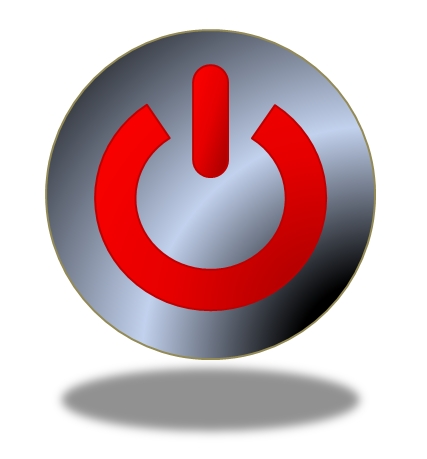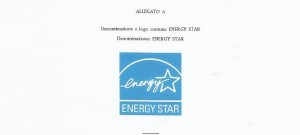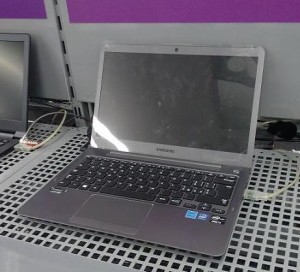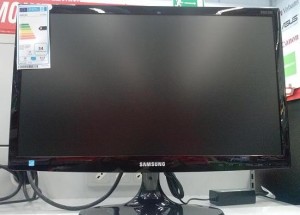
Introduction
In these times when energy saving is very timely especially with the realization of equipment increasingly attentive to the consumption of electricity, with this article I want to focus on that dot always on, usually red in color, which represents the stand-by of almost all modern electrical and electronic equipment; a bright dot that is generally considered annoying but completely harmless (see Fig 1).
The stand-by function and the new European directives
In reality in this condition the electricity consumption turns out to be a waste because it is still consumed even when the machines are not performing their primary function.
With the aim to significantly reduce the consumption of electricity, in July 2005, the European Union adopted Directive 32/2005 EuP (Energy using Products) concerning the energy-saving electrical and electronic products. This Directive lays down rules for the design of the devices as a function of energy consumption.
In 2009 the European Union has also issued a new directive ErP (Energy related Products) that extends its scope to all products that use, generate, transfer and measure the energy. The ErP Directive was enacted as a result of the strategic plan “20-20-20” with which the European Union has set the following objectives to be implemented by 2020:
- 20% reduction of greenhouse gas emissions;
- 20% increase of the energy saving;
- 20% increase of energy from renewable sources.
Consequently, the new Directive concerns products regulated by the earlier directive such as household appliances, as well as other categories such as insulation and windows. Actually the ErP Directive lays down general rules for eco-design, while the specific compliance requirements are described in detail in the Measures Application IM (Implementing Measures).
Here is a list showing some of the many IM that have been posted for electrical and electronic equipment:
- 1275/2008 Power consumption in standby and off of electrical and electronic household and office;
- 244/2009 Non-directional household lamps;
- 642/2009 Television;
- 643/2009 Refrigeration appliances for household use;
- 1015/2010 Washing machines for domestic use;
- 1016/2010 Dishwasher for domestic use;
- 327/2011 Fans with electric input power between 125 W to 500 kW;
- 206/2012 Air conditioners and fans;
- 194/2012 Directional lamps with light emitting diodes and related equipment;
- 617/2013 Computers and computer servers;
- 666/2013 Vacuum Cleaner
- 4/2014 Motor;
- 66/2014 Ovens, hobs, cooker hoods for domestic use;
- 548/2014 Power transformers small, medium, large.
The electronic state of half asleep
For several years, most of the electronic devices are designed to operate in stand-by mode. This feature allows a certain electrical and/or electronic equipment (TV, decoder, video recorders, home theater systems, video game consoles, stereos, toys, printers, appliances, etc..) to remain on (active stand-by) without performing its main function as a VCR on, but that does not record or play back, or to stay off (passive standby), but it can be remotely turned on by remote control.
Then there are certain devices which do not have the remote control and are equipped with appropriate “power plug” which remain powered even if the corresponding device is switched off (power for cordless phones, battery chargers for cell phones and laptops, speakers for computer fixed). Finally, in many electrical and electronic equipment, there are lights that indicate the presence of voltage when the plug is inserted into the socket.
Technically, the stand-by function is an electronic circuit that always remains in operation, waiting for a given signal, as if the device continuously remains in a state of “half asleep electronic”.
This means that even if not in operation, due to the presence of these power circuits and lights, a specific device still absorbs a certain amount of energy which if properly quantified can reach significant digits. According to several statistics this kind of energy “not required” is on average about 15% of the total electricity used in the home or office. This is without doubt a significant percentage especially if you think that involves a consumption made only to keep the equipment out.
It is generally believed the stand-by light as a harmless bright dot, maybe annoying, but absolutely harmless; instead, especially devices with remote control and/or status indicators, if left constantly on standby, they typically consume almost the same amount of energy needed for their occasional use.
In the design of modern electrical systems the problem of turning off all loads used is not easy to solve because the new technologies of Home and Building Automation allow the control sockets both individually and in groups within the appropriate scenarios defined by the user , or all together if you want to be sure, before leaving home or going to bed, turn off all users except those priority (refrigerator, water heater, alarms, etc.).
For existing installations instead, you can use the specific power sockets with timer that solve the problem at low cost, or in cases where the system allows it, you can locate the relevant lines sockets from the general framework and control them through the use of a contactor controlled by a programmable clock with the possibility of exclusion through the manual / automatic, or alternatively you can use multiple sockets 2P + E 16 A, with light switch where to connect all devices in stand-by mode. For example, you can connect the TV, the different decoder and the VCR to the power strip and then turn them off all acting only on the switch light.
The applicative regulation CE 1275/2008
The EC Regulation 1275/2008 published in the Official Journal of the European Union on 18/12/2008, “defines the specific eco-design requirements in relation to the electricity consumption in standby and off modes and applies to electrical and electronic equipment for house and office“. Annex I, shown in Fig.2, describes in detail the equipment, on which the “ecodesign” requirements covered by this European regulation must be applied.
The Regulation provides in Article 2, the following definitions:
“Electrical and electronic household and office equipment” all equipment listed in Annex I that are designed to be used with a rated voltage of 250 V or less;
“stand- by mode” is a condition in which the equipment is connected to the main power source and provides only, and for an indefinite period of time, the functions of: reactivation or reactivation with indication on/off or of the status display;
“Reactivation function” function that allows the activation of the power on by a remote switch or a remote control, internal sensor, timer or other condition that allows additional features;
“Information or status display” continuous function providing information or indicating the status of the equipment, such as clocks or display;
“On-mode” state in which the equipment is connected to the main power source and the main function of the apparatus is turned on;
“Off-mode” state in which the equipment is connected to the main power source but does not perform any function or there is an indication of off-mode condition. It’s also considered off-mode the condition in which only activities that provide the functionality electromagnetic pursuant to Directive 2004/108/EC are provided;
“Information technology equipment” means any apparatus that performs the following primary functions: input, storage, display, retrieval, transmission, treatment, or control the exchange of data or telecommunication messages or a combination of these functions and may be equipped with one or more terminal ports typically used for the transfer of information;
“Home environment” environment where the use of radio, television is at a distance of not more than 10 m.
Regarding the energy consumption, it requires the following “Ecodesign requirements” set out in Annex II:
– Since 1/1/2010, a year after the entry into force, the energy consumption in off-mode and in stand-by mode should not be greater than 1 W, while in stand-by with information or status display mode, should not exceed 2 W;
– Since 1/1/2013, four years after the entry into force, the energy consumption in off-mode and in stand-by should not be greater than 0.5 W, while in stand-by with information or status display mode, should not exceed 1 W; also if the equipment does not perform its main function, it has to be equipped with a device that as quick as possible automatically changes the mode from stand-by to off.
The “ENERGY STAR” program
The ENERGY STAR is a tool on a voluntary basis, adopted in 1993 by the U.S. Environment Protection EPA (Environmental Protection Agency), for computers and monitors with reduced power consumption, and requires compliance with maximum levels of consumption in stand-by mode. Over time the labeling “ENERGY STAR” has spread in the office equipment and also in lighting systems and appliances.
The European Community has introduced the ENERGY STAR, along with the Decision 269/2003, by agreement with the Government of the United States. This agreement was subsequently renewed every five years up to a further renewal for another five years with the decision of the Council of the EU 107/2013 which ratified the agreement, which entered into force on 20 February 2013. The agreement includes the joint coordination of labeling programs for the efficient use of office equipment such as desktop and laptop computers, CAD workstations, small servers, monitors, printers, fax machines, mailing machines, copiers, scanners, multifunction devices.
Annex A of the Agreement shows the name and official logo that can be applied by manufacturers regularly registered with the relevant national brand management or in the commission of the European Community. Some of the recognized national accreditation bodies are:
- ACCREDIA (Italian Accreditation System) for Italy;
- LAB (Laboratory Accreditation Bureau) Indiana, IAS (International Accreditation Service) California, PJLA (Perry Johnson Laboratory Accreditation) Michigan, A2LA (American Association for Laboratory Accreditation) Maryland, for USA;
- UKAS (United Kingdom Accreditation Service) for UK;
- COFRAC (French Accreditation Committee) for France;
- DAkkS (German Accreditation Service) for Germany;
- RvA (Dutch Accreditation council) for the Netherlands;
- ENAC (Entidad Nacional de Acreditacion) for Spain;
- SWEDAC (Swedish Board for Accreditation and Conformity Assessment) for Sweden;
- SCC (Standard Council of Canada) for Canada;
- INMETRO (National Institute of Metrology Standardization and Industrial Quality) for Brazil;
- Hong Kong servizio di accreditamento for China;
- SAC (Singapore Accreditation Council) for Singapore;
- JAB (Japan Accreditation Board), VLAC (Volunteer EMC Laboratory Accreditation Center) for Japan;
- KOLAS (Korea Laboratory Accreditation Scheme) for the Republic of Korea.
For each product, according to the recommendations of the European Community Energy Star Board (ECESB), a committee composed of representatives of the Member States of the European Union and the European Commission, technical specifications for energy consumption are developed and continually revised and updated. All manufacturers must follow them in the design of the equipment in order to obtain and affix the official logo (see Fig. 4).
Manufacturers regularly registered, they can apply the logo “ENERGY STAR” directly to the product and / or accompanying material (eg specifications, packaging, information leaflets). The “ENERGY STAR” is coordinated with other national quality marks and with the EuP Directive (see here)
Some images of electronic products with the ENERGY STAR label
Some Useful Tips
Unfortunately, even today, despite being in force for several years now, many devices are not configured in accordance with the directives IM on energy consumption in stand-by mode. On the market you can find equipment that far exceed the limits imposed by European specifications. For this reason, waiting for a rapid deployment of equipment appropriate to the regulations on energy consumption, it is appropriate to point out the following recommendations:
– for your computer fixed, it is a good idea to pull the plug at the end of day’s work, or at home during the day if absent for work, the circuit stand-by computer generally has a power consumption that can even exceed 10 W depending on the model;
– make sure that washing machines and dishwashers are turned off and the door is closed;
– disconnect, when not in use, all equipment that are equipped with “power plug” (battery charger for mobile phones, powered speakers for computers, printers, etc, from the sockets;
– especially in the home environment, if you do not want to waste time unplugging all the plugs of devices connected to each other (eg, computer, monitor, printer and powered speakers or TV set, cable box, VCR and game console), you can use multiple plugs regularly certified 2P + T 16 A sockets with P17/11 (bivalent) and sockets P30 (schuko); the market offers a wide range of multi-sockets extension specially approved, for example, some multi sockets are controlled with simple light switch (Fig. 5 shows a Scame model).
Other multi-socket extention are with a smart switch as the Beghelli type (see Fig.6), which has the feature to turn off all appliances on standby connected to it both with a button and with a IR remote control.
Alternatively you can use the devices to be inserted between the socket and the equipment such as pins with programmable timer (see Fig.7).
– when you purchase household appliances, pay close attention to the technical characteristics, especially in the period of Christmas gifts where the opportunity to purchase equipment out of the norm at a favorable price, it is very high. As it is known, the appliances are classified into white (refrigerators, dishwashers, washing machines, electric ovens, air conditioners, gas cookers, etc.), blacks (TVs, VCRs, camcorders, radios, cameras, etc.), gray (computers, monitors, printers , scanners, multifunction devices, etc.) and small appliances (irons, electric shavers, vacuum cleaner, hair dryer, etc.). As for the white ones there is an obligation of the energy label, there is no requirement for those blacks, grays and small appliances. For this reason, before you make a purchase, you have to check carefully the energy label, where is mandatory (the white ones). For those blacks and / or gray and / or small appliances, you must check for guarantee marks such as the brand name “ENERGY STAR” or carefully consider the technical characteristics to orienting purchase those products with a reduced power consumption in stand-by or with an auto power off function. For example, with the HDMI (High Definition Multimedia Interface) when decoder, home theater, DVD player are connected to a TV and this is put into standby mode, it automatically put on stand-by all peripheral devices;
– possibly prefer LED TVs than Plasma or LCD and laptops than fixed ones;
– carefully evaluate the technical characteristics of videogames, according to various surveys market techniques. Some models absorb almost the same amount of energy regardless whether they are on or off.










